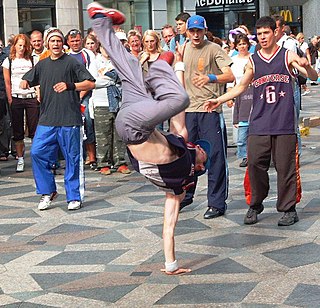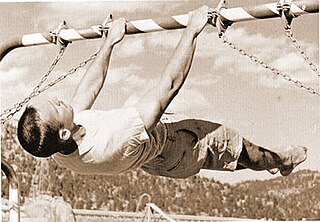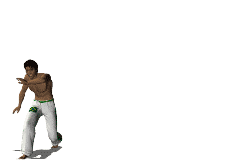
Gymnastics is a type of sport that includes physical exercises requiring balance, strength, flexibility, agility, coordination, artistry and endurance. The movements involved in gymnastics contribute to the development of the arms, legs, shoulders, back, chest, and abdominal muscle groups. Gymnastics evolved from exercises used by the ancient Greeks that included skills for mounting and dismounting a horse, and from circus performance skills.

Calisthenics or callisthenics (/ˌkælɪsˈθɛnɪk/) is a form of strength training that utilizes an individual's body weight as resistance to perform multi-joint, compound movements with little or no equipment.

The rings, also known as still rings, is an artistic gymnastics apparatus and the event that uses it. It is traditionally used only by male gymnasts, due to its extreme upper body strength requirements. Gymnasts often wear ring grips while performing.

A somersault is an acrobatic exercise in which a person's body rotates 360° around a horizontal axis with the feet passing over the head. A somersault can be performed forwards, backwards or sideways and can be executed in the air or on the ground. When performed on the ground, it is typically called a roll.

A handstand is the act of supporting the body in a stable, inverted vertical position by balancing on the hands. In a basic handstand, the body is held straight with arms and legs fully extended, with hands spaced approximately shoulder-width apart and the legs together. There are many variations of handstands, all of which require the performer to possess adequate balance and upper body strength.

The bridge is an exercise. Many variations of this exercise are employed throughout the world, most commonly the balancing of the body on the hands and the feet. It is intended to improve lower back and gluteus strength. Examples of bridging in sportive or self-defense applications are seen in Kung Fu, Judo, Brazilian jiu jitsu, Capoeira, mixed martial arts, and wrestling.

An aerial cartwheel or side aerial is an acrobatic move in which a cartwheel is executed without touching hands to the floor. During the execution of a standard cartwheel, the performer's body is supported by the hands while transitioning through the inverted orientation whereas an aerial cartwheel, performer is airborne while inverted. To compensate for lack of support from the hands, leg momentum is employed to keep the performer airborne until the leading foot touches down. Aerial cartwheels can be executed while running or from a stationary, standing position. The front leg lunges and the back leg drives back creating momentum. Aerial cartwheels are also known by various other names, including side flip, side somersault, air cartwheel, no-hands cartwheels, or simply aerials.

A handspring is an acrobatic move in which a person executes a complete revolution of the body by lunging headfirst from an upright position into an inverted vertical position and then pushing off from the floor with the hands so as to leap back to an upright position. The direction of body rotation in a handspring may be either forward or backward, and either kind may be performed from a stationary standing position or while in motion.

In weight training, a kettlebell is a cast-iron or cast-steel ball with a handle attached to the top. It is used to perform many types of exercises, including ballistic exercises that combine cardiovascular, strength and flexibility training. Kettlebells are the primary equipment used in the weight-lifting sport of kettlebell lifting.

The flare is an acrobatic move in which the performer alternates balancing the torso between either arm while swinging the legs beneath in continuous circles. It is a fundamental b-boying/bgirl power move, and in gymnastics it may be performed on a pommel horse or during the floor exercise. The move is commonly spelled flair in gymnastics and further may be called a "Thomas flair" after its originator, Kurt Thomas.

A freeze is a b-boying technique that involves halting all body motion, often in an interesting or balance-intensive position. It is implied that the position is hit and held from motion as if freezing in motion, or into ice. Freezes often incorporate various twists and distortions of the body into stylish and often difficult positions.

Aú batido is a traditional capoeira cartwheel kick, known under various names in breakdancing, MMA and other disciplines.

Martelo (hammer) is the name for roundhouse kick in capoeira. The kick targets the head of the opponent with the top of the foot.

The front lever is a gymnastic and calisthenic move - a static hold normally performed on the still rings or the pull-up bar. A front lever is performed by lowering from an inverted hang until the body is completely horizontal and straight with the front of the body facing upwards. An accomplished gymnast may also pull directly into the horizontal position from a dead hang. Front levers require a high degree of back and core strength.
This is a general glossary of the terms used in the sport of gymnastics.

An acrobatic flip is a sequence of body movements in which a person leaps into the air and then rotates one or more times while airborne. Acrobatic flips are performed in acro dance, free running, gymnastics, cheerleading, high jumping, tricking, goal celebrations and various other activities. This is in contrast to freestyle BMX flips, in which a person revolves in the air about a bicycle.
A roll is the most basic and fundamental skill in gymnastics class. There are many variations in the skill. Rolls are similar to flips in the fact that they are a complete rotation of the body, but the rotation of the roll is usually made on the ground while a flip is made in the air with the hips passing over the head and without any hands touching the ground. Rolls also help recover from a fall safely.

Virabhadrasana or Warrior Pose is a group of related lunging standing asanas in modern yoga as exercise commemorating the exploits of a mythical warrior, Virabhadra. The name of the pose derives from the Hindu myth, but the pose is not recorded in the hatha yoga tradition until the 20th century. Virabhadrasana has some similarity with poses in the gymnastics of Niels Bukh the early 20th century; it has been suggested that it was adopted into yoga from the tradition of physical culture in India at that time, which was influenced by European gymnastics.

Aú is the capoeira term for a cartwheel. The purpose of the "aú" in capoeira includes mobility, offense and evasion. The aú has similarity to handstand in capoeira (bananeira), but it differs because the body rotates laterally with an energetic impulse.


















